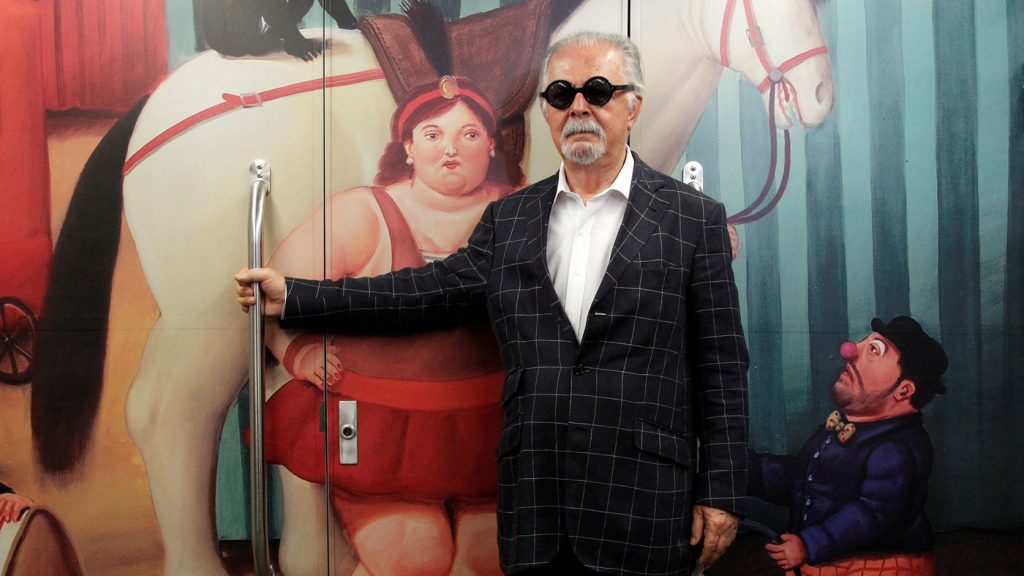
Colombian painter and sculptor Fernando Botero poses inside the “Tren de La Cultura” (“Train of Culture”), during a news conference for the exhibition “Fernando Botero: The Circus,” in Medellín, Colombia, Jan. 30, 2015.
Fredy Builes/Reuters
hide caption
toggle caption
Fredy Builes/Reuters

Colombian painter and sculptor Fernando Botero poses inside the “Tren de La Cultura” (“Train of Culture”), during a news conference for the exhibition “Fernando Botero: The Circus,” in Medellín, Colombia, Jan. 30, 2015.
Fredy Builes/Reuters
BOGOTA, Colombia — Fernando Botero, one of Latin America’s most celebrated artists, has died. According to his daughter, Lina Botero, the 91-year-old Colombian artist was suffering from complications from pneumonia and died at his home in Monaco.
“Fernando Botero, the painter of our traditions and defects, the painter of our virtues, has died,” Colombian President Gustavo Petro announced on social media.
In his paintings and sculptures, Botero often depicted rotund, whimsical figures that poked fun at the upper class of his native Colombia.
Born in Medellín, he was the son of a traveling salesman and a seamstress and once harbored a desire to be a matador.
He spent most of his life living in Europe and the United States, but often returned to Colombia for inspiration. His home city has declared a week of mourning in his honor.

Colombian artist Fernando Botero’s artwork is showcased at the the Bowers Museum in Santa Ana, Calif., on Sept. 10, 2009. The exhibit “The Baroque World of Fernando Botero” was the first major U.S. retrospective presented in more than 30 years by Botero.
Damian Dovarganes/AP
hide caption
toggle caption
Damian Dovarganes/AP

Colombian artist Fernando Botero’s artwork is showcased at the the Bowers Museum in Santa Ana, Calif., on Sept. 10, 2009. The exhibit “The Baroque World of Fernando Botero” was the first major U.S. retrospective presented in more than 30 years by Botero.
Damian Dovarganes/AP
Botero’s works are instantly recognizable. His figures are corpulent and slightly absurd and gave rise to the term “Boterismo” to describe the voluptuous, almost cartoonish figures in his artwork.
One painting depicts a Roman Catholic cardinal fast asleep in full clerical garb. Another shows a snake about to bite the head of a woman posing for a family portrait.
Later in his career, Botero turned to darker subjects, like drug violence in Colombia. During an open-air concert in his home town of Medellín in 1995, guerrillas from the Revolutionary Armed Forces of Colombia, or FARC, placed an explosive device beneath his bronze sculpture, “Pájaro” (“Bird”), killing more than 20 people and injuring more than 200.

An exhibition dedicated to Colombian artist Fernando Botero during a press preview at the Vittoriano museum in Rome, on May 4, 2017.
Tiziana Fabi/AFP via Getty Images
hide caption
toggle caption
Tiziana Fabi/AFP via Getty Images

An exhibition dedicated to Colombian artist Fernando Botero during a press preview at the Vittoriano museum in Rome, on May 4, 2017.
Tiziana Fabi/AFP via Getty Images
He also painted victims of U.S. abuse at the Abu Ghraib prison in Iraq. “These works are the result of the indignation that the violations in Iraq produced in me and the rest of the world,” he said.
His works were hugely popular, sometimes selling for millions of dollars, and adorned major museums as well as the Champs-Élysées in Paris and Park Avenue in New York, as well as his home town of Medellín and the capital Bogotá, where the Botero Museum resides.
